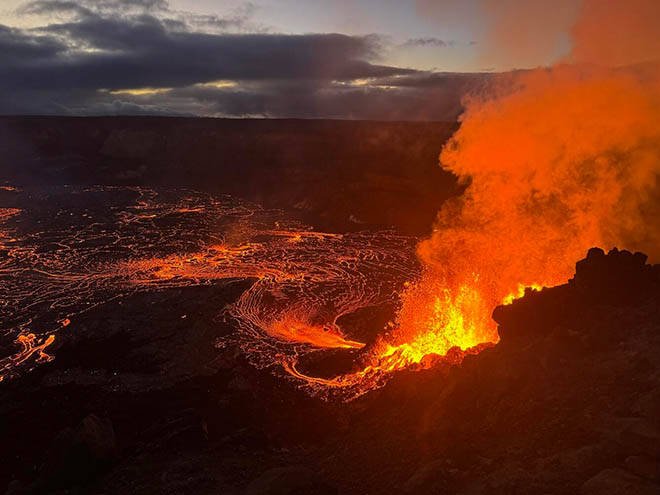Hawaii health officials warn public about Kilauea vog risk

USGS PHOTO by M. PATRICK
Fountaining from the north vent feeds a lava flow spreading east across Kilauea’s crater floor during Episode 11 of the ongoing eruption on Wednesday.
State Department of Health officials are advising residents and visitors to monitor air quality conditions due to the ongoing eruption of Kilauea within Hawaii Volcanoes National Park.
Elevated levels of volcanic gas are contributing to volcanic smog, or vog, and sulfur dioxide levels have been fluctuating, particularly downwind of the summit.
The department encourages the public to check the Hawaii Air Quality Data and the Hawaii Interagency Vog Information Dashboard Opens in a new tab for updates on air quality conditions.
During periods of vog, department officials recommend that individuals, especially those with respiratory conditions like asthma or chronic lung disease, reduce outdoor activities, keep medications accessible and follow prescribed routines.
Vulnerable groups, including children and the elderly, should avoid strenuous exercise and outdoor exposure. The individuals should stay indoors, keep windows and doors closed, and use air conditioners set to recirculate air, officials said.
Masks, while helpful for filtering hazardous particulates from volcanic ash or Pele’s hair, do not provide protection against sulfur dioxide or vog, they said. It is also important to stay hydrated, avoid smoking or second-hand smoke, and heed warnings from emergency management officials, according to the Health Department.
Don't miss out on what's happening!
Stay in touch with breaking news, as it happens, conveniently in your email inbox. It's FREE!
Hawaiian Volcano Observatory scientists said Kilauea has been erupting intermittently since Dec. 23, with the eruption marked by “episodic fountaining,” a behavior not seen in previous eruptions at Halemaumau since 2020. The fountains and lava flows have emerged from two vents, the north and south vents.
There have been 11 fountaining episodes, ranging from a few hours to over a week in length.
On Wednesday, the latest summit eruption paused, with U.S. Geological Survey scientists predicting a new fountaining episode within the next four to six days. Despite the pause, volcanic gas emissions remain high, contributing to poor air quality and potential hazards like Pele’s hair and other volcanic fragments, officials said.
The volcano is at Alert Level Orange, which means that air quality is unhealthy for sensitive groups.
Air monitoring stations on Hawaii island and Maui have recorded elevated levels of sulfur dioxide and particulates. Southerly winds this weekend may lead to poor air quality for the islands.




